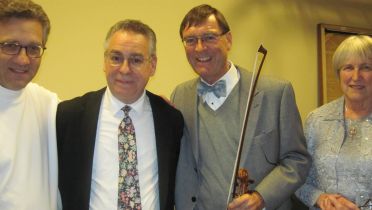|
Chamber
FRISSON DELIVERS SHIVERS OF DELIGHT
by Abby Wasserman
Sunday, March 30, 2025
Chamber
THE PARKER CAPTURES DEMANDING ADES QUARTET AT RAC SEBASTOPOL CONCERT
by Peter Lert
Saturday, February 15, 2025
Chamber
SPLENDID ECHOES ACROSS THE BAY
by Abby Wasserman
Sunday, February 9, 2025
ETHEREAL DUO IN WEILL HALL RECITAL
by Pamela Hicks Gailey
Thursday, February 6, 2025
ESPANA SEGURO AT SO CO PHIL'S JACKSON THEATER CONCERT
by Terry McNeill
Sunday, February 2, 2025
Choral and Vocal
MASTERFUL SINGING CLASS IN SCHROEDER HALL
by Pamela Hicks Gailey
Sunday, February 2, 2025
Recital
MUSICAL POT POURRI AT SPRING LAKE VILLAGE RECITAL
by Terry McNeill
Friday, January 31, 2025
CELLO AND CLARINET HIGHLIGHT TRIO NAVARRO'S CONCERT
by Ron Teplitz
Sunday, January 26, 2025
SONGS OF LOVE, IN A WARM TRIO
by Pamela Hicks Gailey
Sunday, January 26, 2025
Symphony
EARTHLY PLEASURES AT THE VALLEJO SYMPHONY
by Peter Lert
Sunday, January 19, 2025
|
 |
|
CHAMBER REVIEW
Green Music Center / Sunday, March 31, 2013
Trio Navarro and Friends. Roy Malan, violin; Jill Rachuy Brindel,cello, William Klingelhoffer, horn; Natalie Parker, clarinet; Marilyn Thompson, piano
|
 Brian Wilson, William Klingelhofffer, Roy Malan, Marilyn Thompson In Weill March 31 |
THE FAMILIAR, THE RARE AND THE NEW
by Terry McNeill
Sunday, March 31, 2013
Sonoma State's resident Trio Navarro has a well-earned reputation for eclectic programming, and in their Easter Sunday concert in Weill Hall, they chose the familiar, the rare and the new.
The new was SSU faculty composer Brian Wilson's "And Ezra the Scribe Stood Upon a Pulpit," a trio for horn, violin and piano. It proved to be a tantalizing 14-minute score, beginning with a rumble and a descending sets of chords, with William Klingelhoffer's delicately audible horn emitting hushed staccato notes. The piece's air of mystery suited the references to the Torah, and it had insistent rhythms throughout.
Violinist Roy Malan had extended solo passages in sections reminiscent of jazz motifs, often over an Alberti bass figure from pianist Marilyn Thompson. The work ended with the violin the top of its range, to eerie effect. Similar to all of Mr. Wilson's music I have heard, "Ezra" is deftly written and uses instrumental timbres effectively to create absorbing music.
Brahms' familiar E Flat Horn Trio, Op. 40, came next in a capable performance that never quite soared in the large Weill space. Mr. Klingelhoffer played in a seamless style that melded well with the violin and piano, but the sonic fabric in both the Scherzo and Adagio movements was sporadically muddy. As was the case with one of the Trio's previous performances in Weill, the piano sound was indistinct and tended to recede into the mix, moving the violin to the forefront.
The thick and muted sonics in the Brahms may have been a byproduct of the size of the crowd. With only 150 people in Weill's 1,400 seats, the sound lacked focus. Possible solutions to this sonic anomaly include shutting the east-side curtains, installing a shell, or moving chamber music concerts to the soon-to-be-completed Schroeder Hall.
Curiously, the acoustics of the concluding work--Vaughan Williams' rarely hear early Quintet in D--were distinct. Clarinetist Natalie Parker and cellist Jill Brindel joined the three other musicians to play this four-movement composition, which is long on bucolics but short on concise structure. Fragments of themes abound, and the march-like Andantino features a lovely tune, but the overall impression of this 1898 work is one of youth and more important things to come.
|

